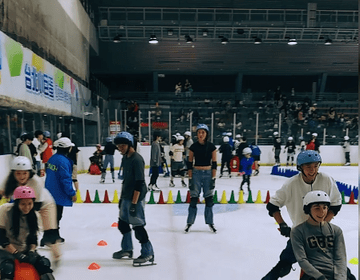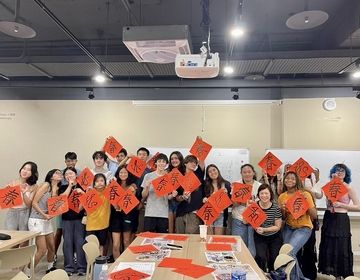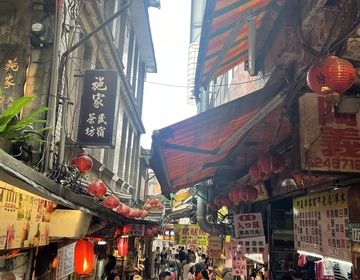A Modern-day Escapade into Historic Tainan
This past weekend, students journeyed to Tainan to explore its profound historical significance as one of the Taiwan's oldest cities. Initially established by the Dutch in the early 17th century, Tainan thrived as a crucial center for trade and cultural interchange throughout Taiwan's colonial eras.
Day 1:
The morning of the Tainan trip, excitement filled the air as students gathered in the lobby, eager to begin the 2-night overnight excursion of the program. Suitcases piled up in the lobby of the school building, final bathroom breaks were taken, and Taiwan’s summer rain gave us a soaked sendoff as we boarded the buses.
After an entertaining 4-hour bus ride where students split their attention between the views of the countryside, their friends and their phones, it was time for dinner! Students broke off into groups and ventured onto Hainan Road to discover local food and dishes like beef soup, beef liver and beef heart! Then after a tiring but adventure-packed day, students settled into their rooms at Hotel Tainan, trying their best to obey the 9pm curfew.
Day 2:
First on the agenda for Saturday was The National Museum of Taiwan Literature (NMTL). This is Taiwan's first national museum dedicated to literary arts, featuring contemporary European architecture by Moriyama Matsunosuke. Students were immersed into Taiwan's rich literary legacy from Indigenous cultures to pivotal historical periods like the Dutch, Ming, Qing, and Japanese eras. It’s becoming more clear to the students just how diverse and intricately complicated this wonderful island is!
Students then took a short walk to the awe-inspiring Tainan Confucius Temple. Founded in 1665 during the Ming Dynasty, the temple was established to promote governance, culture, and education. Our excellent tour guides explained the importance of Taiwan's first educational institution and pointed out the incredible architecture to our eager (but already sleepy) eyes.
After that morning of history, students sat down to enjoy a traditional lunch consisting of famous dishes from Tainan such as Hundred Year Dan Zai Noodles, Deep-Fried Shrimp Roll, and Braised Pork Rice. Some students really enjoyed each dish, while others took a more tentative approach to trying these new combinations of flavors, textures, and ingredients. Overall, this meal gave students a taste (pun intended) of the culinary heritage and local flavors that define Tainan's rich culture.
We then took a short bus ride to 10 Drum Cultural Village. This village is an artistic hub dedicated to traditional drumming. Housed in a renovated sugar refinery, it features performances by the Ten Drum Art Percussion Group, drumming workshops, and cultural exhibitions, blending historical architecture with vibrant art to celebrate Taiwan's musical heritage. We watched an exhilarating drum performance, and then students also tapped into their musical abilities and took a drum lesson, learning about the rhythm and sounds of the place.
We then wrapped up the day!
Day 3:
Our final day in Tainan began with breakfast at the hotel - students chose from an array of dishes ranging from pastries to noodles.
We then hopped on the bus and went to Anping Old Street where students expressed themselves through “sword painting”. The "Sword lion," an emblematic figure of Anping in Tainan, holds deep cultural significance as a symbol of blessing and warding off malevolent forces. This distinctive icon is revered for its historical roots and is believed to safeguard the community with its powerful presence, embodying both tradition and spiritual protection against adversity and negativity.
After lunch, we ventured back to Taipei. Continuing with the theme of self expression through art, students did karaoke: singing songs with their Program Leaders by Justin Bieber, Brittany Spears, and Nikki Minaj. The bus ride was certainly entertaining and got everyone’s energy reloaded.
Then, as quickly as it had happened, the overnight trip was over. Students were excused to practice what has now become a learned skill: navigating Taipei’s fantastic metro and bus system in order to go home to their host families. They returned to what has become familiar to them: their host siblings and host parents, their cooking and finally, their beds.
Author: Isabelle Peel
Related Posts
A Journey into Calligraphy: American High School Students' Chinese Character Exploration in Taiwan
This summer, a group of American high school students embarked on a cultural exploration journey to Taiwan to learn Chinese. They not only studied the language but also delved deeply... keep reading
Discovering Taiwan Through ShiFen and Jiufen
The Journey Begins: Shifen Shifen, a small town known for its historic railway and breathtaking waterfall, was the first stop on the students' itinerary. The journey to Shifen itself was... keep reading


